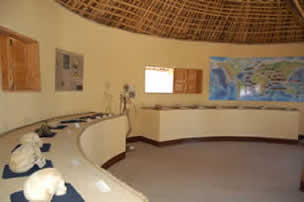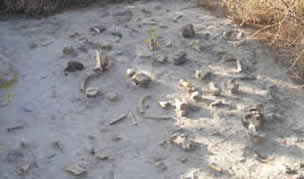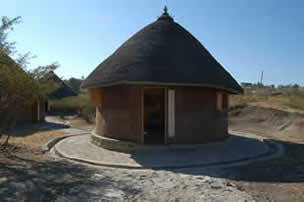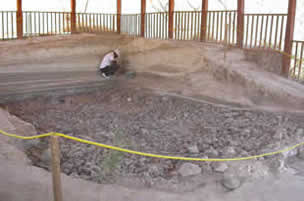- | Home
- | Melka Kunture
- | History of Research
- | Museum
- | For Scientists
- | Bibliography
- | Culture 2000 |
The Melka Kunture Virtual Museum

The Melka Kunture Museum
The realization of this Virtual Museum is one of the main objectives of the Culture 2000 project “From the Past to the Present in Ethiopian Prehistory. An Interactive Museum for the Archaeological Park of the Early Palaeolithic site of Melka Kunture”.
The Melka Kunture Virtual Museum is designed for students, educators, keen on prehistory, and the general public to enhance their understanding of the site of Melka Kunture and of the African Prehistory. The archaeological record is inserted in a large framework which contains geological, paleontological and palaeoanthropological information.

Tukul 3, an internal view

Tukul 4, detail of the exposed materials from Gombore I
Organisation
The Melka Kunture Museum consists in two parts:
Four museal structures (Tukuls), where you can explore:
1. the most important East African prehistoric sites and the protagonists of the African Prehistory (Tukul 1);
2. the geological aspects of Melka Kunture and the principles of Geology and Volcanology related to them (Tukul 2);
3. the history of the Human Evolution (Tukul 3);
4. the archaeological, paleontological and palaeoanthropological records from Melka Kunture (Tukul 4).
The Open Air Museum.
Part of the area of Melka Kunture has been transformed into a natural-archaeological Park where both the archaeological and environmental features of the site can be visited.

Open Air Museum, the Butchering Site
The Open Air Museum consists in two areas:
1. At the locality of Gombore II a Middle Acheulean site was excavated and preserved in situ for an extension of more than 40 m2.
This paleosurface is extremely rich both on faunal remains and on lithic artefacts. The site is preserved by a wooden construction of a large roof built in local style.
2. The second area prepared for visitors is the so called Gombore II Butchering Site. More than 250 casts of paleontological and lithic remains found during previous excavations have been positioned on the paleosurface.
Help to navigation

External view of Tukul 1, African Prehistory
You can visit the four structures utilizing the plan of the Tukuls, arranged in an order that we call the "Guided Tour". Clicking on one of the tukuls, you can see the relative detailed plan, in which the location of all the panels and the showcases are displayed. By selecting one panel, you can read all the information and visualize all the pictures contained in the panel. If you select a showcase, you can see the image of the material exposed.
In the Tukuls 1 and 4, a list located under the plan of the Museum provides more information about respectively other East African and Melka Kunture sites, which have not been exposed in the Museum.
All the Melka Kunture sites are linked to the Web GIS (you can select the link or go directly to the menu “For Scientists”. If you choose this option, you can visit the Melka Kunture territory and you can explore all the archaeological plans of the different sites and the relative data.
In particular, you can visit the two paleosurfaces of the Open Air Museum at Gombore II. One of this has been recorded through stereoscopic photogrammetry. In this case, if you do not have the occasion to go to Melka Kunture, you can have a real look of this paleosurface with a click of the mouse.

Open Air Museum, the paleosurface